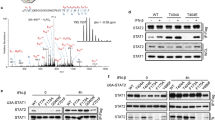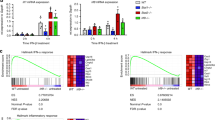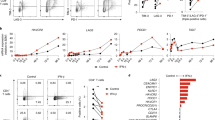Abstract
Interferon Regulatory Factor (IRF)-1 has been characterized as an important growth regulatory and immunomodulatory transcription factor. To further characterize the potential targets of IRF-1 antiproliferative activity, IRF-1 was expressed under the control of the tetracycline-inducible system in murine NIH3T3 cells. Due to their ability to mimic IRF-1 transactivator function, the regulatory potential of IRF-1/RelA and IRF-2/RelA fusion proteins consisting of the DNA binding domains of IRF-1 or IRF-2 fused to the transactivation domain of NF-κB RelA(p65) was also examined. Cells inducibly expressing IRF-1 or IRF/RelA in response to doxycycline treatment displayed significantly reduced growth rates compared to control cells, and inhibition of cell growth correlated directly with the level of transgene expression. Interestingly, IRF-1 and IRF/RelA expression also induced a low level of apoptosis, as detected by microscopic analyses. Furthermore, expression of the interferon inducible, double stranded RNA dependent kinase PKR was increased following IRF-1 or IRF/RelA induction. Most strikingly, induction of IRF-1 and IRF/RelA expression resulted in a significant increase in STAT1 (p91) protein and increased ISGF3 DNA binding activity, suggesting that IRF-1 tumor suppressor activity may involve a novel mechanism which activates the JAK-STAT pathway through STAT1. WAF1 levels were also constitutively elevated in IRF-1 and IRF-1/RelA cells. These studies demonstrate that inducible expression of the transactivation function of IRF-1 or IRF/RelA mediates tumor suppressor activity by inducing cell growth arrest, apoptosis and the differential activation of growth regulatory genes such as PKR, STAT1 and WAF1.
This is a preview of subscription content, access via your institution
Access options
Subscribe to this journal
Receive 50 print issues and online access
$259.00 per year
only $5.18 per issue
Buy this article
- Purchase on Springer Link
- Instant access to full article PDF
Prices may be subject to local taxes which are calculated during checkout
Similar content being viewed by others
Author information
Authors and Affiliations
Rights and permissions
About this article
Cite this article
Nguyen, H., Lin, R. & Hiscott, J. Activation of multiple growth regulatory genes following inducible expression of IRF-1 or IRF/RelA fusion proteins. Oncogene 15, 1425–1435 (1997). https://doi.org/10.1038/sj.onc.1201318
Received:
Revised:
Accepted:
Issue Date:
DOI: https://doi.org/10.1038/sj.onc.1201318
Keywords
This article is cited by
-
Transient oscillatory dynamics of interferon beta signaling in macrophages
BMC Systems Biology (2013)
-
Identification of gene biomarkers for respiratory syncytial virus infection in a bronchial epithelial cell line
Genomic Medicine (2008)
-
IRF-1 expression induces apoptosis and inhibits tumor growth in mouse mammary cancer cells in vitro and in vivo
Oncogene (2004)
-
IRF-1 reverts the transformed phenotype of oncogenically transformed cells in vitro and in vivo
Oncogene (2003)
-
Myeloid Differentiation (MyD)/Growth Arrest DNA Damage (GADD) genes in tumor suppression, immunity and inflammation
Leukemia (2002)



